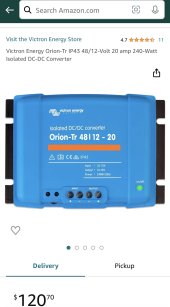bds70
New Member
I get to feeling like I am asking too many dumb questions. Hope I don't wear you guys patience out.Remember it’s a journey not a race keep researching stuff on the forum and asking questions you will get there it just takes time
I get to feeling like I am asking too many dumb questions. Hope I don't wear you guys patience out.Remember it’s a journey not a race keep researching stuff on the forum and asking questions you will get there it just takes time
There is no such thing as a dumb question everyone has different knowledge levels on many different topics a question is just a search for knowledgeI get to feeling like I am asking too many dumb questions. Hope I don't wear you guys patience out.
YesWould this be the sort of suitable converter?
you can but not going with native voltage you can run into battery balance issues and you have to be sure they can be put is series but a additional balance unit can be used to solve that problemBUT, if I was to build either 4 12v units or 2 24v units then join them in series, apart from the extra cost of having multiple bms, would that be a feasible solution to getting 48V?
Hmmmm, might have to look at a way to lift a 16s setup into the locker. Might be time to start welding up a new designYes
you can but not going with native voltage you can run into battery balance issues and you have to be sure they can be put is series but a additional balance unit can be used to solve that problem
I’m close to your age and I’m lift limited myself. The general consensus around here is if you need 48 or 24 volt lithium batteries, buy 48 or 24 volt batteries. Eventually one battery will be out of balance to the others when they are put in series. You can buy a battery balancer (not to be confused with a bms) they are not perfect but they work, it just adds something that can go wrong. I’d probably recommend several EG4 48 100 ah sealed types in parallel. The are for marine and RV, have an app, 200 amp bms, about 85 pounds. Yes those little converters do work well, but get the largest version in that style(fined). For some reason they are more efficient than the mid sized. Test it with load, the last unit I got couldn’t do half of the load. You could possibly put several in parallel. Do fuse it!Would this be the sort of suitable converter?
Due to the weight of 16s cells as one battery, it would be just about impossible for me (I am 70) to be able to get it into or out of the bus solar locker.
BUT, if I was to build either 4 12v units or 2 24v units then join them in series, apart from the extra cost of having multiple bms, would that be a feasible solution to getting 48V?

Lower Ah packs are smaller & lighter, put multiple into parallel to get the total capacity you need, while each individual battery is not too heavy.
An 8s pack of 25Ah cells will be much lighter than an 8s pack of 50Ah cells. There are options to keep the weight you have to lift lower.8s pack would come in at about 50kg. That's probably my top lift limit but would be manageable. Geez I have so much rolling around my head right now.
Thanks for the help
Yup, cept I am looking at 280ah cells. I need the watt hour capacity.An 8s pack of 25Ah cells will be much lighter than an 8s pack of 50Ah cells. There are options to keep the weight you have to lift lower.
Would a 12v deep cycle do the job, or maybe a smaller capacity lifepo4 say 50ah maybe?Keep in mind the a converter by itself may not have current available to drive the macerating toilet. To charge a lead acid battery will need something smarter than just a step down converter.


If the pack will be 'too heavy' then use parallel sets of smaller cells, ie instead of 280Ah cells in a single pack of 8s, build/buy two packs using 140Ah cells for example, and the weight per pack will be about half as much. Easier to lift and move around, if that is still a concern. My own ESS is now 68kWh made up from 6 separate 16s packs. But I seldom need to move any of them.Yup, cept I am looking at 280ah cells. I need the watt hour capacity.
If I have a 48v bank, and a step down to 12v converter, to a 12v battery, with the 48v being constantly charged wouldn't that also then be charging the 12v battery?Keep in mind the a converter by itself may not have current available to drive the macerating toilet. To charge a lead acid battery will need something smarter than just a step down converter.


